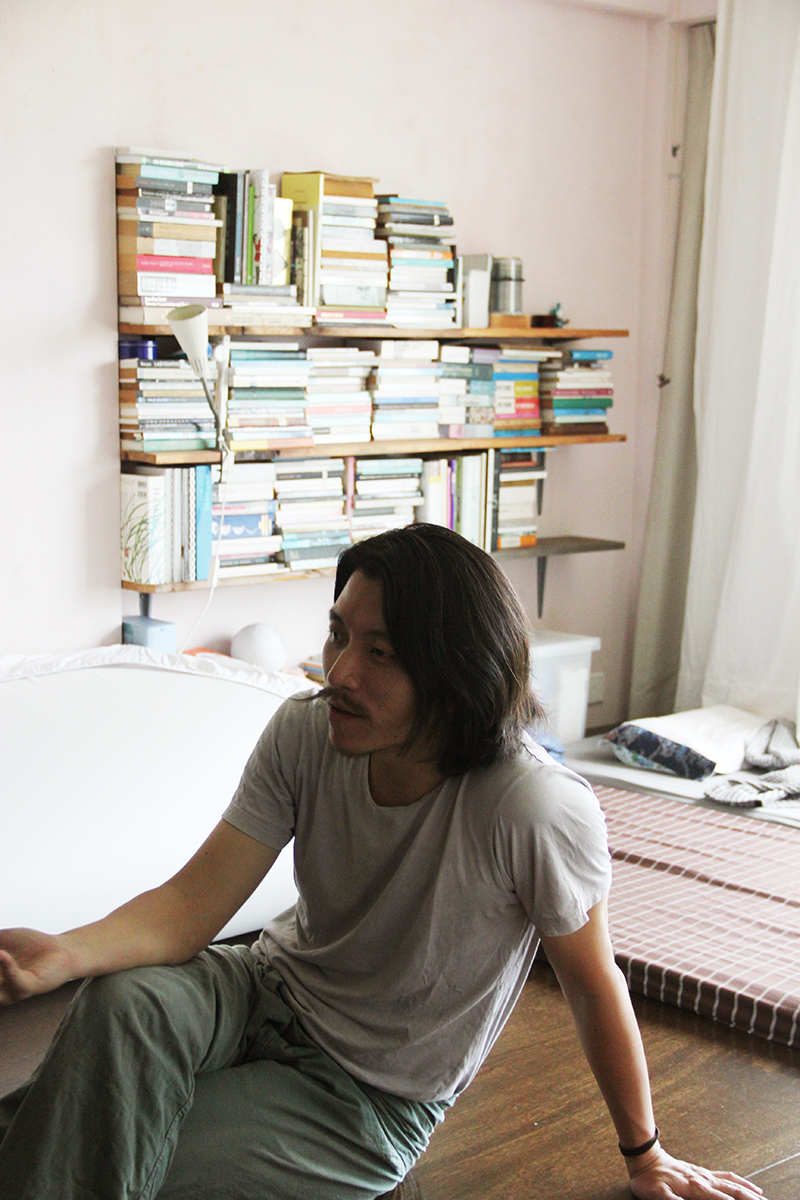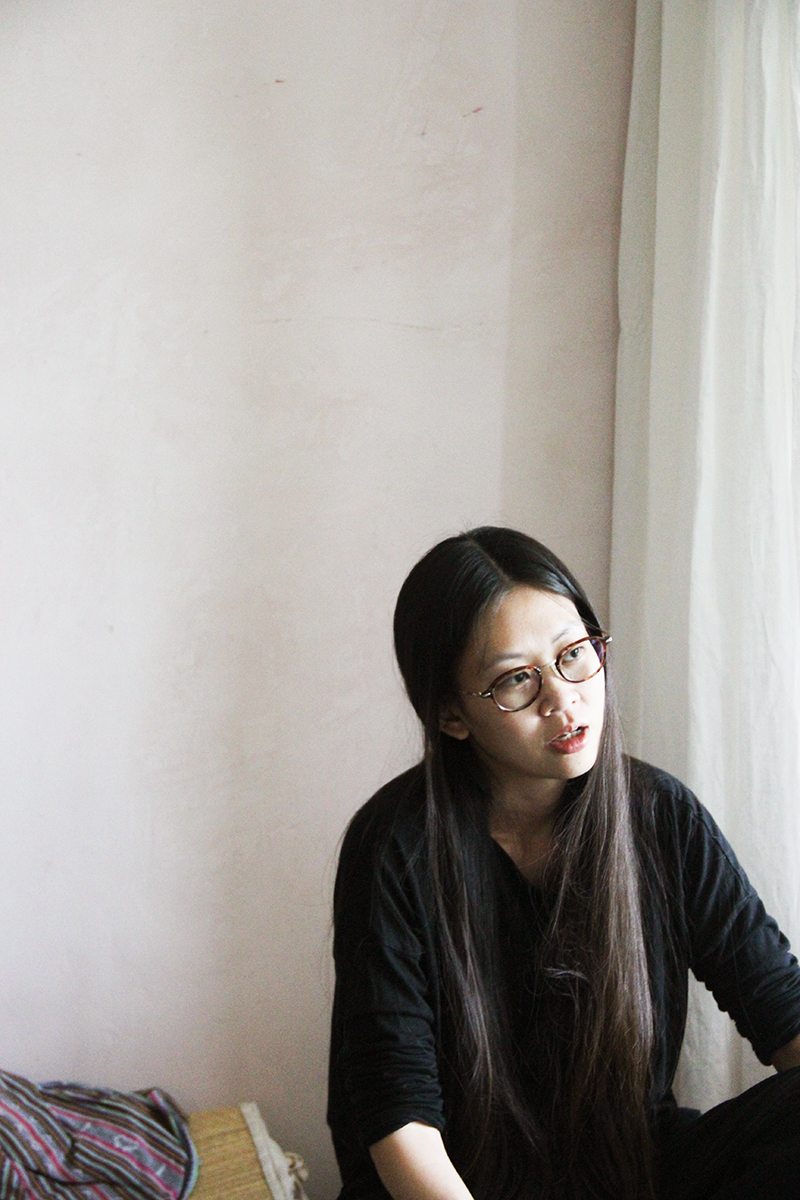A collection of conversations with a diverse range of local and regional creatives
Library Conversations for SGABF2020
We examined the systems that support art book making and independent art book publishing in Singapore and the region.
A Closer Look for SGABF2019
We gathered perspectives on our zine and art book culture, and discuss the possibilities of self-publishing today.
21 Creatives for SGABF2018
We sat down with 21 creatives of various disciplines to learn about their practice and asked each of them to fill up a blank page in a notebook.
SGABF: How do you approach the different mediums (i.e. installations and publications) in order to best portray your ideas?
HOKO: It depends on the content and the context. Some are experimental, like our first issue of Science of the Secondary, Apple. We did not want to launch it in a bookstore. We wanted to bring the experience closer to people, so we placed our book at fruit stalls where people can buy it and get a complimentary apple with it.
For the Door, Window, and Pipe issues, we initially imagined a huge exhibition with different types of doors, windows and pipes, but then we thought, “What are we going to do with these after the exhibition ends?” So we produced postcards instead, to allow people to experience the exhibition in the comforts of their own homes.
We always have the design angle in mind, and we think that designers can be more sensitive to everyday things. To design a chair, one should be able to understand, study and observe what it means to sit, rather than simply drawing a chair. Designers would put out all these designs that do not make sense, and we did not want to participate in that; we wanted to address the idea of being aware. Being aware of drinking from a cup will allow you to buy a better cup to suit your needs. It is about empowering the people first, then letting the designers be guided by the consumers’ needs. That is the motivation behind what we do.

Photo Credit: SGABF
SGABF: Your projects are in-depth studies of common objects that we might otherwise take for granted. For your experiential installation, Café Cup, you created 17 cup prototypes that would elevate the drinking experience beyond the taste of the beverage. Tell us a little more about the installation.
HOKO: We wanted to let people encounter the act of drinking. A lot of people asked, “drink already, then what?” The cups were not randomly designed and they are not just different for the sake of being different. They were derived from the research and observations from Science of the Secondary: Cup. The prototypes have a direct link to the findings, like the way we slurp from cups, and how the act of drinking changes when we remove our hands from the whole equation.
SGABF: You have brought your installations to different countries like Taiwan and Japan. What were the responses like in these countries and how was it different from Singapore's?
HOKO: The fundamental difference is that Singaporeans generally do not have the culture of attending events like Café Cup and people do not know how to respond and behave when they do attend. People from different countries respond to cultural events differently. The Japanese are well-oiled and know what to expect because they are more exposed to events and exhibitions like these. They understood the concept right away without much explanation.
SGABF: Your works’ aesthetics, paired with the introspective theme of your projects, induce a feeling of slowing down. Is that your underlying philosophy?
HOKO: I don't know if it is considered slowing down, but it comes naturally from our manual and slow processes. Our photos still use film - they are grainy, unpolished, and unedited. Although we do set deadlines for our projects for the sake of disciplining ourselves, we're not the type to rush.
In Science of the Secondary: Egg, the illustrations were done with only cut-and-paste functions, which took a lot more time and effort than simply just drawing. We could have drawn it, but the entire book would have been full of circles and ovals without dimension or texture.

Photo Credit: SGABF
Trial and error is a long and manual process but we do that a lot. We don't know how to use a digital camera, so we use a film camera. In a way it is more convenient because we do not have to edit the pictures, we use whatever comes out. Because we are neither illustrators nor writers, we come up with the creative direction and find ways of doing things that work for us.
Ultimately, we do our work for ourselves. When we’re curious about something, the excitement comes from here first, between the both of us. When it gets translated into a book and whether or not it excites other people when they read it, is no longer our problem because those are things we cannot control. Must always ownself happy first.

Photo Credit: SGABF
SGABF: In your opinion, what should the role of Singapore Art Book Fair be in improving the social standing of the arts and culture in Singapore, and what should it aim to achieve?
HOKO: It provides a platform for people to talk about art and books. Otherwise, it is easy for people to think that art is constricted to only a few mediums, like paintings and sculptures, and that should not be the case.

Photo Credit: SGABF
The good thing about books is that it is relatively affordable and can be easily distributed, compared to a costly painting that hangs on a single collector’s wall. So as a medium, books are still very powerful.
The Singapore Art Book Fair should reiterate the idea of books as a medium, and even inspire people to think about how they want to display their works. Robert Zhao is a good example; every one of his work turns up in the form of a book and he uses it as a way to talk about and display his art. Galleries and museums can sometimes feel very superficial or inaccessible, so a book is still the best and most convenient form for the masses.
Atelier HOKO (2002) is an independent research lab that focuses on the study of the growing disengagement between people, things and space. The atelier hopes to cultivate in people, an openness and ability to un-know, bringing about a heightened curiosity towards all phenomena by taking a fresh look at reality. Founded by Alvin Ho and Clara Koh.
www.atelierhoko.com/
© Singapore Art Book Fair 2025. All rights reserved.
For further enquiries, please contact us at info@singaporeartbookfair.org.
Singapore Art Book Fair is organised by

For further enquiries, please contact us at info@singaporeartbookfair.org.
Singapore Art Book Fair is organised by

